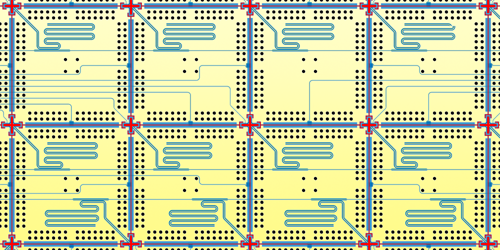Quantum Chip Cuts Unintended Signals
One challenge for scaling up quantum computers to larger numbers of quantum bits (qubits) is crosstalk, where a signal meant to control the state of a certain qubit unintentionally affects a nearby qubit. Now Sandoko Kosen of Chalmers University of Technology in Sweden and his colleagues have demonstrated a 25-qubit, low-crosstalk integrated circuit whose design can be scaled up to larger quantum processors in the future [1].
As the number of qubits and qubit-coupling components (“couplers”) on a chip increases, so does the number of wires and the amount of crosstalk. Kosen and his colleagues previously developed a two-qubit chip with two layers: one for qubits and couplers and one for control and readout circuitry [2]. Some of the wires used electric fields to control qubits, while others used magnetic fields to control couplers. Their new, 25-qubit design builds on this architecture and achieves a high density of components that is well suited to incorporating more qubits.
Despite the high component density, the researchers showed that their design led to crosstalk as low as that of almost any other quantum processor. A version of the chip in which the wires were shielded by 3-µm-high metal structures didn’t improve the crosstalk for the electric-field-producing wires, suggesting that crosstalk from these wires is not caused primarily by direct electric-field interactions with the wrong qubits. But Kosen and his colleagues say that more research is needed to determine the crosstalk’s sources. They also found that crosstalk in their circuit decreases with distance by about 1 dB/mm, which is half the dropoff rate they predict a 100-qubit quantum processor would require. The team suggests the improvements needed to close this gap.
–David Ehrenstein
David Ehrenstein is a Senior Editor for Physics Magazine.
References
- S. Kosen et al., “Signal crosstalk in a flip-chip quantum processor,” PRX Quantum 5, 030350 (2024).
- S. Kosen et al., “Building blocks of a flip-chip integrated superconducting quantum processor,” Quantum Sci. Technol. 7, 035018 (2022).




